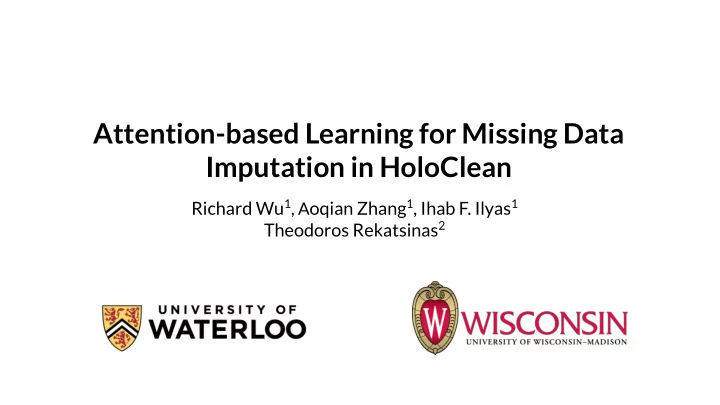

Attention-based Learning for Missing Data Imputation in HoloClean Richard Wu 1 , A oqian Zhang 1 , Ihab F. Ilyas 1 Theodoros Rekatsinas 2 1 2
Problem Missing data is a persistent problem in many fields ● Sciences ○ ○ Data mining ○ Finance Missing data can reduce downstream statistical power ● Most models require complete data ● 2
Modern ML for Data Cleaning: HoloClean Framework for holistic data repairing driven by probabilistic inference ● Unifies qualitative (integrity constraints and external sources) with ● quantitative data repairing methods (statistical inference) Available at www.holoclean.io 3
Missing Values in Real Data sets 4
Challenges Values may not be missing completely at random (MCAR/i.i.d.) but ● systematically Mixed types (discrete and continuous) introduce mixed distributions ● Drawbacks of current methods: ● Heuristic-based (impute mean/mode ) ○ Requires predefined rules ○ Complex ML models that are difficult to train , slow , hard to interpret ○ 5
Contribution A simple attention architecture that exploits structure across attributes Our results: > 54% lower run time than baselines ● Missing at random (MCAR) : 3% higher ● accuracy and 26.7% reduction in normalized-RMS Systematic : 43% higher accuracy and ● 7.4% reduction in normalized-RMS 6
How does AimNet improve on the MVI problem? Key idea: Exploit the structure in data model that learns schema-level relationships between attributes dot product attention 7
Architecture overview (1) Model mixed data Encode w/ non-linear ● Step 3 layers (continuous) Embedding lookup ● (discrete) Step 2 (2) Identify relevant context Attention helps identify ● schema-level importance (3) Prediction Inverse of encoding ● Step 1 (continuous) Softmax over possible ● values (discrete) Learned via self-supervision: mask and predict observed values 8
How do we encode mixed types? Convert context values to vector embeddings. [0.1, 1.2, -5, 2, 15] Output: [1, 0, -1.3, 5, -7] embeddings Dense layer (5x5) (Name, Joe) [0, 2, -1, 2.5, 1] (City, Chicago) [1, 0, -1.3, 5, -7] Activation (Zip Code, 10010) ... Dense layer (5x2) (City, Chicago) [-12, 3.5] Input: raw data Continuous values Discrete values 9
Attention layer Attention where Q/K are derived from attributes rather than values Output: [-1, 5, 0.5, 1.2, -2] context vector [0.09, 0.90, 0.01] Target: County T ) softmax(QK County (K) (City, Chicago) (Zip code, 60603) (Age, 35) [1, 0, -1.3, 5, -7] [1.2, 0.5, -2, 3, 5] [0, 1, 2, 3, -1.5] (V City ) (V Zip code ) (V age ) 10
Prediction Input: context vector [-1, 5, 0.5, 1.2, -2] matmul County A: [0, 100, 0, 0, 0] T County B: [0, 0, 0, 0, 50] T Dense layer (5x5) softmax Activation [0.99, 0.01] Dense layer (1x5) Output: 100600 Output: County A Salary (continuous) County (discrete) 11
Questions Can AimNet impute missing completely at random ( MCAR/i.i.d. ) values? ● Does AimNet's emphasis on structure help it with systematic bias in missing ● values? Can we interpret the structure that AimNet learns in the data? ● 12
Mostly discrete Experimental setup 14 real data sets ● Missing types ● MCAR/i.i.d. ○ Systematic ○ Evaluation ● Accuracy (discrete) ○ normalized-RMS (continuous) ○ Mostly continuous Training: self-supervised learning where targets = observable values ● 13
Experiment results > 54% lower run time than baselines ● Missing at random (MCAR) : 3% higher accuracy and 26.7% reduction in normalized-RMS ● Systematic : 43% higher accuracy and 7.4% reduction in normalized-RMS ● Attention identifies structure between attributes that helps it deal with systematic bias in missing values 14
HCQ XGB MIDAS GAIN MF MICE MCAR (20%) HoloClean with XGBoost Denoising GAN Random Linear regression with quantization Autoencoder Forest multiple iterations AimNet outperforms on both discrete and continuous attributes on almost all data sets 3% in accuracy ● 26.7% in NRMS ● 15
Chicago taxi data set Benchmark in TFX data validation pipeline ● Pickup/dropoff info, fare, company ● Naturally-occurring missing values w/ ground truth ● Systematic bias between companies ● All within "17031040401" census tract 16
Chicago taxi: naturally-occurring missing data Values are missing systematically (not i.i.d.) ● Attention learns relationship between ● Census Tract and Latitude/Longitude 17
Chicago taxi results AimNet outperforms baselines by a huge margin Accuracy: 73% vs 27% (XGB) ● Run time: 53 mins. vs 124 mins (HoloClean w/ Quantization) ● 18
What if we inject systematic errors into other real data sets? AimNet still outperforms baselines in almost all cases 19
Does the attention layer actually help? As the domain size increases , attention leads to better performance Learns schema-level dependencies ● 5 classes 50 classes 200 classes 20
Architecture summary Encode : learns projections for continuous and embeddings for discrete ● data Structure : new variation of attention to learn structural dependencies ● between attributes Prediction : mixed-type prediction using projections (continuous) and ● softmax classification (discrete) 21
Conclusion A simple attention-based architecture modestly outperforms existing ● methods on i.i.d. missing values AimNet outperforms state of the art in the presence of systematically ● missing values by a large margin Attention mechanism learns structural properties of the data which ● improves MVI with systematic bias 22
Appendix 23
Hyperparameter Sensitivity 24
Multi-task and Single-task 25
MCAR (40% missing) results 26
MCAR (60% missing) results 27
Census Tracts form Voronoi-like cells 28
Recommend
More recommend